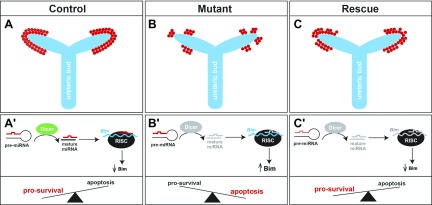Figure 7.
Proposed model for Bim function in nephron progenitors during kidney development. A–C) In control kidneys, nephron progenitors (red) form a cap of cells surrounding the ureteric bud tips (blue) (A); whereas in mutant kidneys, the deletion of Dicer from nephron progenitors results in premature ablation of this cell population (B). The loss of Bim partially restores the number of progenitors in Dicer-deficient kidneys (C). A′–C′) Pre-miRNAs are cleaved by Dicer to produce mature miRNAs. Mature miRNAs recognize specific binding sites on the 3′-UTR of the Bim mRNA, recruit the RNA-induced silencing complex (RISC), causing either Bim mRNA degradation or its translational repression. During kidney development, low Bim levels in nephron progenitors allow this cell population to be maintained (A′). In mutant kidneys, the absence of Dicer impairs the formation of mature miRNAs, resulting in increased Bim expression, and nephron progenitors preferentially undergo apoptosis (B′). In heterozygous rescue and homozygous rescue kidneys, nephron progenitors lacking mature miRNAs also display reduced or absent expression of Bim mRNA, which in turn favors cell survival (C′).

